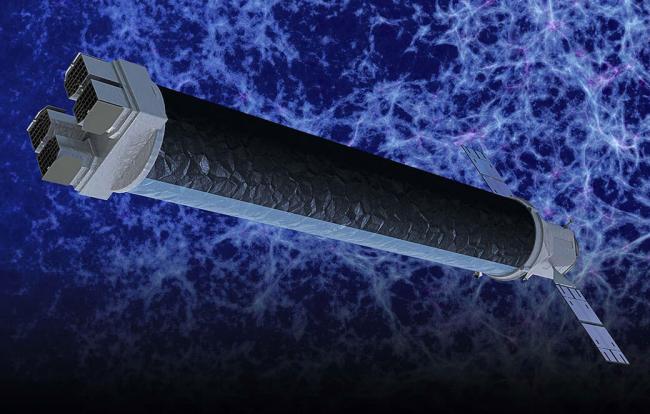Arcus
The most powerful astronomical events are often very bright in X-rays, including supermassive black holes, the hot atmospheres of stars, and the extremely hot plasmas in and around galaxy clusters. Arcus is a proposed NASA space telescope designed to study the X-ray spectrum of a wide range of astronomical phenomena to a level of sensitivity higher than any previous X-ray observatory. Center for Astrophysics | Harvard & Smithsonian scientists are the leaders of the collaboration proposing Arcus. The mission proposal will be due in late 2023 and, if ultimately accepted, Arcus would launch in 2031.

An artist's impression of the proposed Arcus X-ray observatory, which will provide detailed information on the X-ray spectrum of many astronomical systems. The Arcus spacecraft will orbit Earth in a wide elliptical path.
The Telescope and the Science
The design of Arcus will allow it to observe a wide variety of astronomical systems, including dust surrounding newborn stars, the hot plasma both inside and outside galaxy clusters, the outflow of material from supermassive black holes at the centers of galaxies, and many others. This will provide valuable insight into the formation and evolution of structure in the universe, as well as the complex interactions between black holes and their host galaxies.
Arcus will be an X-ray spectrometer, which means rather than capturing images of its objects of study, it will split the light into its component wavelengths. That reveals information about the composition, ionization, and velocity of the source. Arcus is designed to fill a need in X-ray astronomy, offering capabilities no other current or future mission has. Complementary to NASA’s Chandra X-ray Observatory, Arcus will measure the spectrum of X-ray sources with as much as a hundred times the sensitivity of other X-ray telescopes, including other future observatories.
The spacecraft carrying the spectrometer is the same basic platform as many other NASA observatories, including the TESS exoplanet hunter. Arcus will orbit Earth in a wide ellipse to provide clear views of the sky, using the combined gravity of Earth and the Moon to stabilize its trajectory and save on fuel.
The spectrometer design was originally intended to be part of the International X-ray Observatory (IXO), but split into its own project as a reflection of NASA’s priorities for smaller space missions. The CfA is leading the Arcus project, in collaboration with researchers from NASA's Ames Research Center, NASA’s Goddard Space Flight Center, the Massachusetts Institute of Technology, Pennsylvania State University, and the Max Planck Institute for Extraterrestrial Physics.
- Quasars & Other Active Black Holes
- Spectroscopy
- Elemental Abundances
- Intergalactic Medium
- Solar and Stellar Atmospheres
- Supernovas & Remnants
- Stellar Structure and Evolution
- Black Holes
- Neutron Stars and White Dwarfs
- Galaxy Clusters